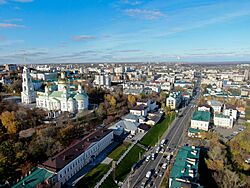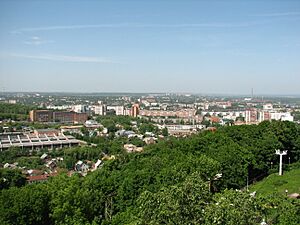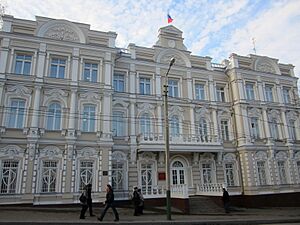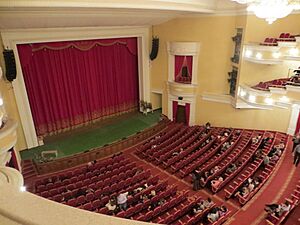Penza facts for kids
Quick facts for kids Penza (English)Пенза (Russian) |
|
|---|---|
| - City - | |
 View of the Church of the Merciful Saviour |
|
|
|
|
| Anthem | none |
| Administrative status | |
| Country | Russia |
| Federal subject | Penza Oblast |
| Administratively subordinated to | city of oblast significance of Penza |
| Municipal status | |
| Urban okrug | Penza Urban Okrug |
| Head | Vladimir Mutovkin |
| Representative body | City Duma |
| Statistics | |
| Population (2010 Census, preliminary) |
517,311 inhabitants |
| - Rank in 2010 | 34th |
| Population (January 2015 est.) | 522,823 inhabitants |
| Time zone | MSK (UTC+04:00) |
| Founded | 1663 |
| Postal code(s) | 440000, 440001, 440003–440005, 440007–440009, 440011–440015, 440018, 440020, 440022, 440023, 440025, 440026, 440028, 440031–440035, 440039, 440040, 440042, 440044–440047, 440049, 440052, 440054, 440056, 440058, 440060–440062, 440064, 440066–440068, 440071, 440072, 440700, 440890, 440899, 440960, 440961, 440999 |
| Dialing code(s) | +7 8412 |
| Official website: http://www.penza-gorod.ru | |
Penza (Russian: Пенза) is a large city in Russia. It is the main city and administrative center of Penza Oblast. Penza is located on the Sura River, about 625 kilometers (388 miles) southeast of Moscow. In 2010, Penza had a population of 517,311 people. This made it the 36th-largest city in Russia at that time.
Contents
What's in a Name?
The city's name, Penza, comes from a local word. It means "end of a swampy river." This name likely describes the area where the city was first built.
City Layout and Design
The center of Penza was once a wooden fortress. This old fortress helped decide where the first streets would go. Its towers and walls guided the direction of the early roads. This is how the first six streets of the city were formed. They were named Governor's, Lekarskaya, Moscow, Nikolskaya, Sadovaya, and Teatralnaya.
The fortress square also created a grid of streets that met at right angles. Over time, the city's design became more organized. In 1785, Empress Catherine the Great approved the first master plan for Penza. The city was rebuilt to have straight streets, similar to Saint Petersburg. This plan helped make Penza's layout unique. Its streets cross each other at right angles, dividing the city into neat blocks.
The old fortress was not just for defense. It was also the main government center for the whole region. It housed the governor, archives, treasury, and a prison. The main church, Spassky Cathedral, and the main square were also inside the fortress. In 1785, the old fortress was taken down. This made space for new stone buildings. These included the bishop's court and the governor's home. The Spassky Cathedral was destroyed in 1934. It was rebuilt between 2010 and 2022.
Ancient Discoveries
In 1927, a piece of a giant marine reptile skull was found near Penza. This reptile was called Mosasaurus hoffmanni. This was the first clear sign of this type of creature in Russia. The fossil was found in very old rock layers from the Late Cretaceous period. Other ancient sea creatures, like Belemnitella lanceolata and B. americana, were also found. These discoveries help scientists learn about life long ago.
Penza's Past
Penza was founded in 1663 as a Russian frontier fortress-city. Its purpose was to protect Russia from attacks. You can still see parts of the old defense lines today. In 1663, architect Yuri Kontransky came to build a stronger fortress. It included a wooden Kremlin, a village, and homes for people. Cossacks were settled here and built a fortress called "Cherkassy Ostroh." This is where Penza grew from. The city's Cossack roots are remembered in street names like Cherkasskaya.
In 1774, a rebel army led by Yemelyan Pugachev took over Penza. The city's people welcomed the rebellious Cossacks. After 1801, the first stone houses started to appear. By 1809, Penza's population grew to over 13,000 people.
During the Russian Civil War, the Czechoslovak Legions started an uprising against the Bolsheviks in Penza. Later, during the Soviet period, Penza became an important industrial city. For example, the Ural mainframe computer was made here from 1959 to 1964.
City Government
Penza is the main administrative center of its region, called an oblast. It is considered a "city of oblast significance." This means it has a special status, similar to a district. For local government, Penza is known as the Penza Urban Okrug.
Getting Around Penza
Penza is a major railway hub. It is also located on the M5 highway, which connects Moscow and Chelyabinsk. Penza Airport offers flights within Russia. For getting around the city, people use buses, trolleybuses, and marshrutkas (shared taxis).
Learning and Arts
Penza is a center for higher education in its region. It has several universities, including:
- Penza State University
- Penza State University of Architecture and Construction
- Penza Artillery Engineering Institute
- Penza State Agricultural University
The city also has 13 colleges and 77 public schools. Penza is home to the Penza Oblast Drama Theater, named after Anatoly Lunacharsky. Another special theater is the Theater of Doctor Dapertutto. It is located in the former home of famous Russian theater director Vsevolod Meyerhold. Penza also has four museums and three art galleries. One unique gallery is The Museum of One Painting.
Weather in Penza
Penza has a humid continental climate. This means it has long, cold winters and warm summers. Summers can be quite warm, even though the city is far north. Winters are very cold compared to other places at the same latitude in Europe. In 2010, Penza experienced a heat wave. Temperatures were much higher than usual for several days.
| Climate data for Penza (1991–2020, extremes 1850–present) | |||||||||||||
|---|---|---|---|---|---|---|---|---|---|---|---|---|---|
| Month | Jan | Feb | Mar | Apr | May | Jun | Jul | Aug | Sep | Oct | Nov | Dec | Year |
| Record high °C (°F) | 7.0 (44.6) |
8.5 (47.3) |
18.3 (64.9) |
28.3 (82.9) |
35.6 (96.1) |
37.7 (99.9) |
39.3 (102.7) |
40.4 (104.7) |
33.6 (92.5) |
25.6 (78.1) |
18.6 (65.5) |
11.0 (51.8) |
40.4 (104.7) |
| Mean daily maximum °C (°F) | −5.5 (22.1) |
−4.5 (23.9) |
1.6 (34.9) |
13.0 (55.4) |
21.5 (70.7) |
24.9 (76.8) |
27.0 (80.6) |
25.4 (77.7) |
18.8 (65.8) |
10.3 (50.5) |
1.3 (34.3) |
−4.0 (24.8) |
10.8 (51.4) |
| Daily mean °C (°F) | −8.6 (16.5) |
−8.5 (16.7) |
−2.9 (26.8) |
7.0 (44.6) |
14.8 (58.6) |
18.6 (65.5) |
20.7 (69.3) |
18.9 (66.0) |
12.9 (55.2) |
6.1 (43.0) |
−1.5 (29.3) |
−6.8 (19.8) |
5.9 (42.6) |
| Mean daily minimum °C (°F) | −11.7 (10.9) |
−12.0 (10.4) |
−6.8 (19.8) |
1.9 (35.4) |
8.6 (47.5) |
12.6 (54.7) |
14.7 (58.5) |
13.1 (55.6) |
8.1 (46.6) |
2.6 (36.7) |
−3.9 (25.0) |
−9.6 (14.7) |
1.5 (34.7) |
| Record low °C (°F) | −39.9 (−39.8) |
−38.3 (−36.9) |
−29.3 (−20.7) |
−16.6 (2.1) |
−5.6 (21.9) |
−0.8 (30.6) |
4.7 (40.5) |
1.4 (34.5) |
−6.4 (20.5) |
−17.1 (1.2) |
−29.7 (−21.5) |
−40.5 (−40.9) |
−40.5 (−40.9) |
| Average precipitation mm (inches) | 41 (1.6) |
34 (1.3) |
37 (1.5) |
38 (1.5) |
45 (1.8) |
62 (2.4) |
56 (2.2) |
52 (2.0) |
50 (2.0) |
47 (1.9) |
44 (1.7) |
43 (1.7) |
549 (21.6) |
| Average rainy days | 6 | 5 | 7 | 13 | 16 | 19 | 18 | 16 | 17 | 17 | 12 | 8 | 154 |
| Average snowy days | 26 | 22 | 16 | 5 | 1 | 0.1 | 0 | 0 | 0.3 | 5 | 17 | 25 | 117 |
| Average relative humidity (%) | 84 | 82 | 79 | 68 | 61 | 67 | 69 | 70 | 73 | 79 | 86 | 85 | 75 |
| Mean monthly sunshine hours | 42 | 77 | 138 | 200 | 275 | 294 | 302 | 260 | 162 | 92 | 45 | 30 | 1,917 |
| Source 1: Pogoda.ru.net | |||||||||||||
| Source 2: Climatebase (sun 1971–2012) | |||||||||||||
Sports Teams
Penza is home to several sports teams:
- Dizel Penza is the city's professional hockey team. They play in the VHL.
- Dizelist Penza is a junior hockey club. They play in the NMHL.
- FC Zenit Penza is the city's football (soccer) team. It was started in 1918.
- Lokomotiv Penza is a professional rugby union club. They play in Russia's Rugby Championship.
Penza has also hosted the Russian Sidecarcross Grand Prix in 2009 and 2010.
Special Recognition
A minor planet discovered in 1978 was named 3189 Penza after the city. This was done by Soviet astronomer Nikolai Chernykh.
Famous People from Penza
Many notable people have come from Penza or have strong ties to the city. Here are a few:
- Denis Ablyazin, a world and Olympic medalist in artistic gymnastics.
- Sergey Andronov, an ice hockey player.
- Egor Kreed, a popular singer and rapper.
- Natalia Lavrova, a world and Olympic champion in rhythmic gymnastics.
- Mikhail Lermontov, a famous poet who grew up nearby.
- Vsevolod Meyerhold, a well-known actor and theater director.
- Maria Sittel, a journalist.
Sister Cities
Penza is connected with other cities around the world as "sister cities." This helps build friendships and cultural exchange. Penza is twinned with:
 Békéscsaba, Hungary (since 1970)
Békéscsaba, Hungary (since 1970) Busan, South Korea (since 2007)
Busan, South Korea (since 2007) Lanzhou, China
Lanzhou, China Ramat Gan, Israel (since 2007)
Ramat Gan, Israel (since 2007) Mogilev, Belarus (since 2008)
Mogilev, Belarus (since 2008)
Images for kids
See also
 In Spanish: Penza para niños
In Spanish: Penza para niños









